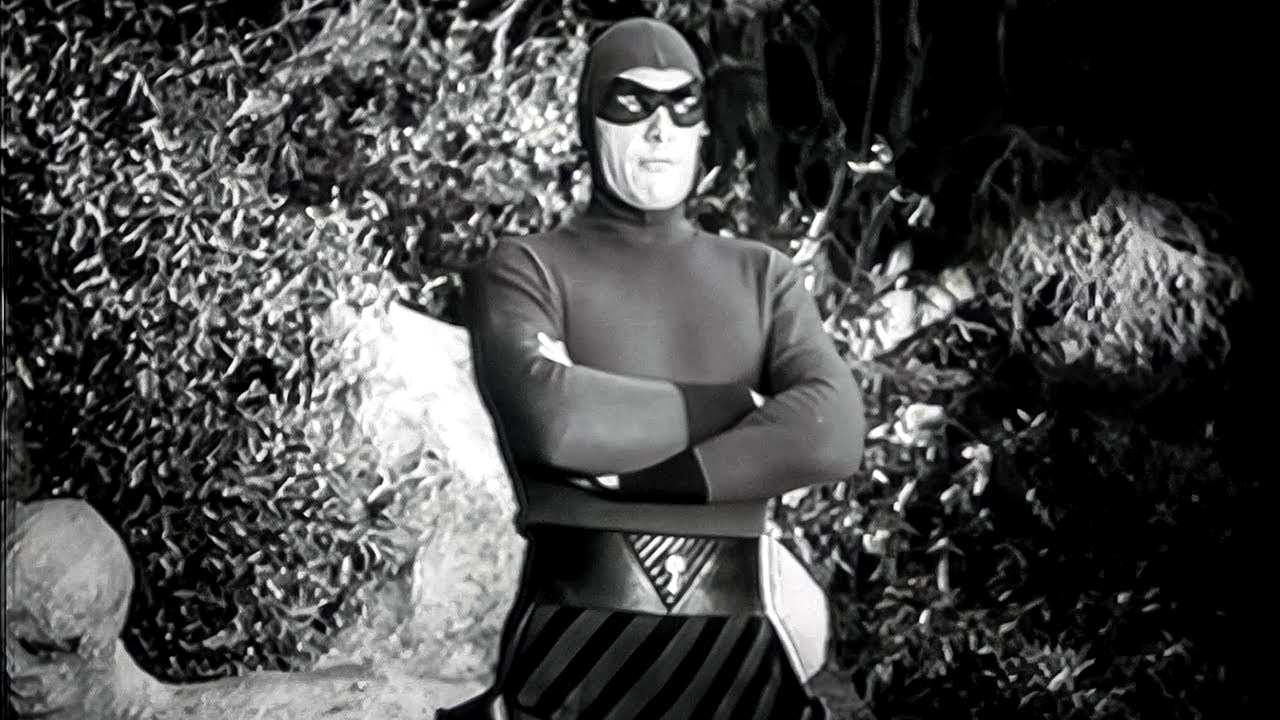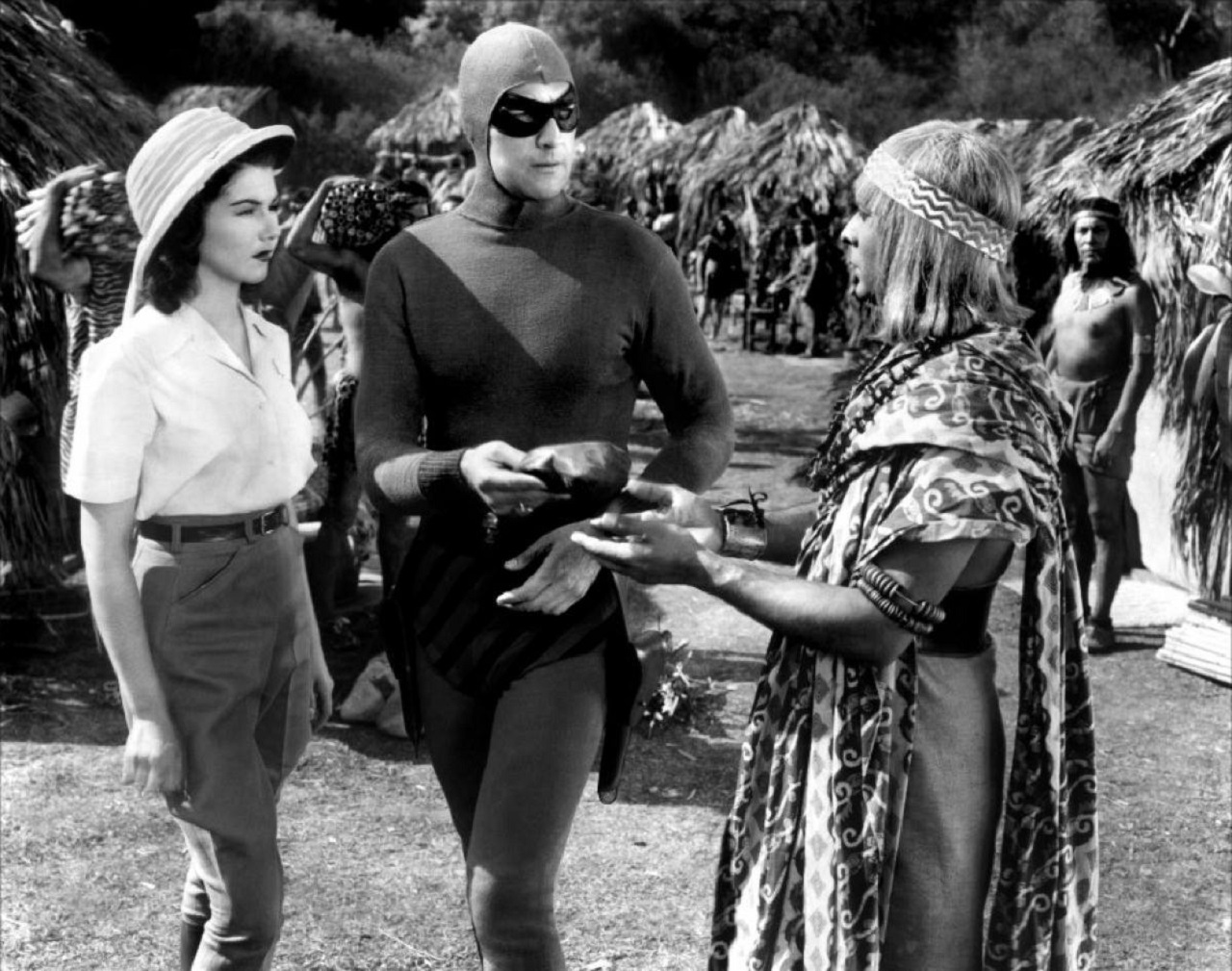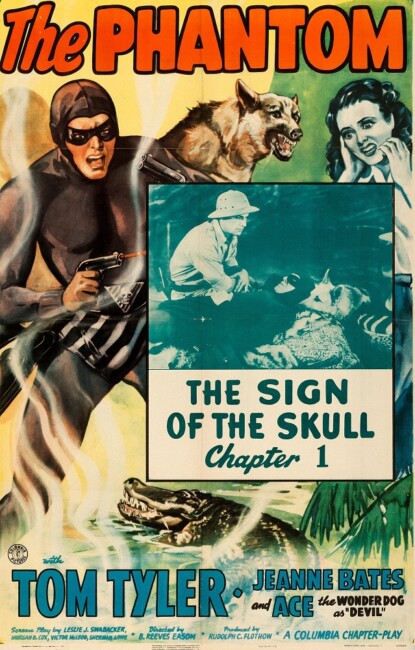USA. 1943.
Crew
Director – B. Reeves Eason, Screenplay – Morgan B. Cox, Sherman Lowe, Victor McLeod & Leslie J. Swabacker, Based on the Comic Strip by Leon [Lee] Falk & Ray Moore, Producer – Rudolph C. Flothow, Photography (b&w) – James S. Brown, Music – Lee Zahler, Art Direction – George Van Marter. Production Company – Columbia.
Cast
Tom Tyler (The Phantom/Geoffrey Prescott), Jeanne Bates (Diana Palmer). [All Others Uncredited] Kenneth MacDonald (Dr Max Bremmer), Frank Shannon (Professor Davidson), Ernie Adams (Rusty Fenton), Joe Devlin (Singapore Smith), John Bagni (Moku), Lal Chand Mehra (Suba), Early Cantrell (The Fire Princess/Ruby Dawn), Robert Barron (King of Zoloz), Guy Kingsford (Byron)
Plot
In the African village of Tonga, the masked white man known as The Phantom rules over the natives, using simply trickery to make them think he has great powers. He is then fatally shot by a blow dart. Geoffrey Prescott is in nearby Sai Pana, preparing to join the expedition of Professor Davidson in search of the lost city of Zoloz, when he receives news that his father, who is The Phantom, is dying. Geoffrey leaves the expedition and heads to The Phantom’s cave where his father bequeaths him the mantle of The Phantom and his duty, as was sworn by those that came before them, to do good and protect the natives. Meanwhile, Professor Davidson and the disreputable Singapore Smith have between them six of the seven pieces of the puzzle that make up the map showing the way to Zoloz and set out to find the seventh. Dr Max Bremmer is determined to get to Zoloz so he can build an airfield and does all in his power to steal the pieces. Standing in their way however is Geoffrey, the new Phantom.
The Phantom is one of the most popular syndicated newspaper comic-strips of all time. It was the creation of Lee Falk, a 23 year-old advertising copywriter from St Louis, Missouri. In 1934, Falk had created the character of Mandrake the Magician for King Features Syndicate, which also became a popular and long-running success in newspapers. King Features pressed Falk to come up with something else and so The Phantom was born. The Phantom premiered in 1936 and still runs to this day. With The Phantom, Lee Falk in fact created the first superhero (or at least non-super-powered masked hero a la Zorro, The Long Ranger and Batman) comic-strip, predating Superman. Falk wrote every episode of the daily strip from 1936 until his death in 1999.
This was a fifteen-chapter serial produced by Columbia and was the first screen appearance of The Phantom. (The other screen versions of The Phantom are listed at the bottom of the page). It was clearly made fairly soon into the comic-strip’s run where Lee Falk can still be credited as Leon Falk. Serials were a form of film-making that has disappeared today. A serial would run to about 15-20 minutes in length and would appear before the main feature (usually along with a cartoon and a newsreel). Each episode would end on a cliffhanger – the genre literally gave birth to the term – with the hero or heroine in some form of peril or thought killed, where audiences would have to wait to the following week to find out how they survived. The serials began in 1913 and found their greatest popularity between the 1930s and 40s. The last serial was produced in 1956, around the exact time that commercial television started to become widespread.
There is an extraordinary commingling between the serial and the growth of the comic-book Superhero. All of the major comic-book heroes and superheroes of this era made their appearance in newspaper strips and later on the comic-book page. Within less than a decade, they had made their way on to the screen in serial versions. Measuring from their first appearance, it would be two years for Flash Gordon (1936), six years for Dick Tracy (1937), ten years for Buck Rogers (1939), five years with Mandrake, The Magician (1939), seven years for The Phantom, two years for Adventures of Captain Marvel (1941), four years for Batman (1943), three years for Captain America (1944) and nine years for Superman (1948). There were also a popular series of Superman and Popeye cartoons produced around this time.

All of these superhero serials suffered an impoverishment of imagination and budget. There was an almost complete lack of super-villains, while the superheroics were conducted on poverty row budgets – Superman was represented by an animated figure whenever he flew, for instance. In some cases – Captain America being an egregious example – the serials threw established continuity completely out the window. On the other hand, The Phantom is one adaptation that pays a great deal of adherence to established canon. The Phantom’s costume bears a close resemblance to the comic-book one. There is Devil the dog (as opposed to wolf), the skull-shaped cave, the hereditary legacy of the Ghost Who Walks. The only major difference is that The Phantom gets the unmasked identity of Geoffrey Prescott, but in all fairness, The Phantom’s regular identity as Kit Walker has not been introduced in the comics at that point (although in a shadow of things to come, Prescott uses the alias Walker at one point).
The Phantom has some of the best cliffhangers of any serial. At the end of the Chapter 1, we have The Phantom trapped in a swamp (standard Hollywood quicksand) as an alligator advances towards him – the resolution in the next chapter has Devil come to the rescue and drive the alligator off and then bring a creeper to Tom Tyler to use as a rope. Even better is the cliffhanger at the end of Chapter 2 where The Phantom is attacked by a lion and we see Tom Tyler pinned on the ground, wrestling the lion with his arm in its’ mouth.
These two are the most dramatic but there are some other fairly solid cliffhangers – Chapter 5 with a fight on a rope bridge over a ravine as the bridge is collapsing; or the end of Chapter 7 where The Phantom is hiding down the bottom of a well and the bad guys batter the stonework and cause the well to collapse in on him (although the resolution in the next chapter where The Phantom just crawls out is lame). The plot is all the usual serial stuff involving lots of running back and forward between various locations with the need to obtain various components in between the ongoing efforts of the bad guys to eliminate The Phantom.

The theme about a white man lording over the ignorant natives plays out fairly badly today, following elevated discussions about colonialism. All the natives speak in Pidgin English. The scenes with The Phantom as benevolent ruler of the natives, fooling them with magical tricks make you do a double take. Of The Phantom it is said he is “a clever showman who exploited the ignorant savages’ superstitious fear.” At another point, The Phantom deals with natives by setting their huts (ie. their homes) on fire and not letting them put the fire out until the chief confesses and tells the truth.
Even more incredulous is the chapters where The Phantom encounters The Fire Princess, a dancer who has been established by the bad guys and keeps the natives in thrall with her fire dance routine and similar magic tricks. With an astonishing hypocrisy, given that he uses such tactics himself, The Phantom’s means of defeating her is to expose her tricks to the outrage of the villagers who rise up against her.
Columbia later made The Adventures of Captain Africa (1955), which started as a sequel to The Phantom but ended up being rewritten when the rights to the comic-strip lapsed. Other versions of The Phantom include the big-budget theatrical film The Phantom (1996) starring Billy Zane; and the tv mini-series The Phantom (2009) starring Ryan Carnes that modernised the character. The Phantom was incarnated into two animated series, Defenders of the Earth (1986-7) where he joined several other King Features heroes – Mandrake the Magician, Flash Gordon and their various siblings – in battling Ming the Merciless, and Phantom 2040 (1994-6), which concerns the activities of the Phantom’s son in a futuristic setting.
Most of the actors cast as the superheroes lacked the ability to fill out the larger-than-life characters but Tom Tyler, who was also the serial Captain Marvel, fills the costume well, showing particularly handsome stature when he plays the Geoffrey Prescott part. Frank Shannon, who plays the professor, was also Dr Zarkov in the Flash Gordon serials. Incredibly enough, Jeanne Bates, who plays the love interest, later went on to play the mother of Jack Nance’s girlfriend in the famous dinnertable scene in Eraserhead (1977).
B. Reeves Eason (1996-1956) had a career between the 1910s and late 1940s. He made numerous Westerns and in the 1930s began to specialise in serials. These include the genre likes of The Phantom Empire (1935), Darkest Africa (1936) and The Undersea Kingdom (1936).
Full serial available here


